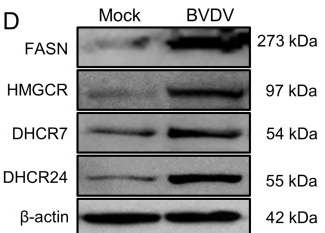DHCR7 Antibody - #DF13577
| Product: | DHCR7 Antibody |
| Catalog: | DF13577 |
| Description: | Rabbit polyclonal antibody to DHCR7 |
| Application: | WB IF/ICC |
| Cited expt.: | WB |
| Reactivity: | Human, Mouse, Rat |
| Prediction: | Pig, Zebrafish, Bovine, Horse, Sheep, Dog, Chicken, Xenopus |
| Mol.Wt.: | 54kDa; 54kD(Calculated). |
| Uniprot: | Q9UBM7 |
| RRID: | AB_2846596 |
Related Downloads
Protocols
Product Info
*The optimal dilutions should be determined by the end user. For optimal experimental results, antibody reuse is not recommended.
*Tips:
WB: For western blot detection of denatured protein samples. IHC: For immunohistochemical detection of paraffin sections (IHC-p) or frozen sections (IHC-f) of tissue samples. IF/ICC: For immunofluorescence detection of cell samples. ELISA(peptide): For ELISA detection of antigenic peptide.
Cite Format: Affinity Biosciences Cat# DF13577, RRID:AB_2846596.
Fold/Unfold
7 dehydrocholesterol reductase; 7 DHC reductase; Delta 7 dehydrocholesterol reductase; Putative sterol reductase SR 2; SLOS; Sterol delta 7 reductase; Sterol Delta;
Immunogens
A synthesized peptide derived from human DHCR7, corresponding to a region within N-terminal amino acids.
- Q9UBM7 DHCR7_HUMAN:
- Protein BLAST With
- NCBI/
- ExPASy/
- Uniprot
MAAKSQPNIPKAKSLDGVTNDRTASQGQWGRAWEVDWFSLASVIFLLLFAPFIVYYFIMACDQYSCALTGPVVDIVTGHARLSDIWAKTPPITRKAAQLYTLWVTFQVLLYTSLPDFCHKFLPGYVGGIQEGAVTPAGVVNKYQINGLQAWLLTHLLWFANAHLLSWFSPTIIFDNWIPLLWCANILGYAVSTFAMVKGYFFPTSARDCKFTGNFFYNYMMGIEFNPRIGKWFDFKLFFNGRPGIVAWTLINLSFAAKQRELHSHVTNAMVLVNVLQAIYVIDFFWNETWYLKTIDICHDHFGWYLGWGDCVWLPYLYTLQGLYLVYHPVQLSTPHAVGVLLLGLVGYYIFRVANHQKDLFRRTDGRCLIWGRKPKVIECSYTSADGQRHHSKLLVSGFWGVARHFNYVGDLMGSLAYCLACGGGHLLPYFYIIYMAILLTHRCLRDEHRCASKYGRDWERYTAAVPYRLLPGIF
Predictions
Score>80(red) has high confidence and is suggested to be used for WB detection. *The prediction model is mainly based on the alignment of immunogen sequences, the results are for reference only, not as the basis of quality assurance.
High(score>80) Medium(80>score>50) Low(score<50) No confidence
Research Backgrounds
Production of cholesterol by reduction of C7-C8 double bond of 7-dehydrocholesterol (7-DHC).
Endoplasmic reticulum membrane>Multi-pass membrane protein.
Widely expressed. Most abundant in adrenal gland, liver, testis, and brain.
Belongs to the ERG4/ERG24 family.
Research Fields
· Metabolism > Lipid metabolism > Steroid biosynthesis.
· Metabolism > Global and overview maps > Metabolic pathways.
References
Application: WB Species: bovine Sample: bovine cells
Restrictive clause
Affinity Biosciences tests all products strictly. Citations are provided as a resource for additional applications that have not been validated by Affinity Biosciences. Please choose the appropriate format for each application and consult Materials and Methods sections for additional details about the use of any product in these publications.
For Research Use Only.
Not for use in diagnostic or therapeutic procedures. Not for resale. Not for distribution without written consent. Affinity Biosciences will not be held responsible for patent infringement or other violations that may occur with the use of our products. Affinity Biosciences, Affinity Biosciences Logo and all other trademarks are the property of Affinity Biosciences LTD.


